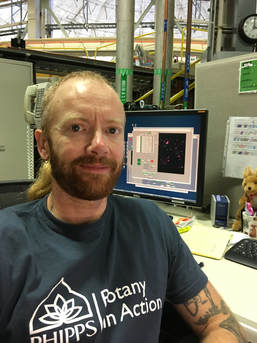 Collecting data on the chemical form of arsenic in the root zone of the arsenic hyper accumulating fern, Pteris vitiate, at the Advance Light Source (Lawrence Berkeley Laboratory, Berkeley, CA). Collecting data on the chemical form of arsenic in the root zone of the arsenic hyper accumulating fern, Pteris vitiate, at the Advance Light Source (Lawrence Berkeley Laboratory, Berkeley, CA). 2017 was an exciting year in the field, lab, and beyond! As the calendar turns I like to look back on the year’s research and outreach accomplishments. Learning new methods: This year I learned a lot of new methods to analyze plant tissue and soil samples for arsenic, most notably how to use synchrotron radiation to understand the chemical form of arsenic in my samples. I logged about 50 hours on the beam line at two facilities. I also learned how to use X-rays in a more portable way, using an X-ray fluorescence (XRF) instrument to analyze contaminant concentrations during real-time sampling in the field. I learned this method while volunteering with EPA personnel at an oil refinery superfund site in Bristow, OK, where I found that lead is a major contaminant at refinery sites, in addition to petrochemicals. I also collaborated with EPA and other agency personnel on a soil sampling methods project here in Richmond, trying to figure out the best way to accurately determine what’s really in the soil. With only a few grams of soil ultimately analyzed in the lab, it makes a big difference how samples are collected from a large lot! 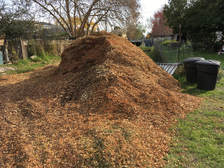 After 4 years growing ferns in our arsenic phytoextraction study at our Berkeley site, we removed a lot of arsenic. The soil is still contaminated, however, so I covered the lot with mulch before leaving. After 4 years growing ferns in our arsenic phytoextraction study at our Berkeley site, we removed a lot of arsenic. The soil is still contaminated, however, so I covered the lot with mulch before leaving. Working in the field: After 4 long, fruitful years working at my Berkeley field site, I completed work there. I took down our hoophouse and gave the materials to the Gill Tract Farm, a UC-community collaboration, and said goodbye to the neighbors. I also completed the final fern sampling at my other field study, a 1 year project in Richmond, CA. One year feels short compared to 4, and while part of me wanted to keep the ferns growing, I’m looking forward to moving from fern tending to data analysis. 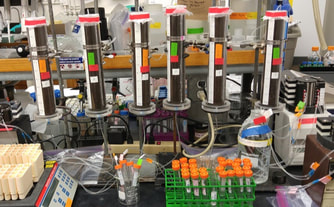 We pack acrylic columns with contaminated soil and run water through, to see how much arsenic leaches from the soil. We pack acrylic columns with contaminated soil and run water through, to see how much arsenic leaches from the soil. Meanwhile, back in the lab: Soil column studies help us understand what happens in the plant root zone. I completed baseline work looking at arsenic leaching from soils without the arsenic hyperaccumulating fern (Pteris vittata), and started soil columns studies with the fern planted in the contaminated soil. We hope to see less leaching when the fern is present, but we might be surprised! It took a long time to find suitable soil at my field site to excavate for these columns, further ingraining the lesson that soil contamination is heterogeneous. Move over 2 feet and voila! Arsenic concentrations are very, very different. 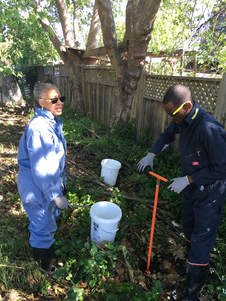 Berkeley Community Gardening Collaborative Project Director Corinne Haskins (left), and Berkeley Technology Academy teacher William Tinson (right) sample soil at the railroad right of way. Berkeley Community Gardening Collaborative Project Director Corinne Haskins (left), and Berkeley Technology Academy teacher William Tinson (right) sample soil at the railroad right of way. Staying true to urban agriculture roots: Even though my work at the Berkeley field site is officially over, I won’t be away for long! I’ll just move to the next adjacent lot on this old railroad right of way, working with high school students, UC undergraduate mentors, and the Berkeley Community Gardening Collaborative to test soil for contaminants. This is the next step in moving this 6-lot-long brownfield towards urban agriculture use. I also continued work this past year with Urban Tilth, helping them test and rehabilitate the soil at their North Richmond Farm. In the coming year my collaborator Joshua Arnold and I will work with them on a project using the forage radish to “organically” punch through compacted soil and add organic matter in daikon-sized chunks (mmm, delicious!). Josh and I were honored to receive the Chancellor’s Award for Public Service for this community focused work. 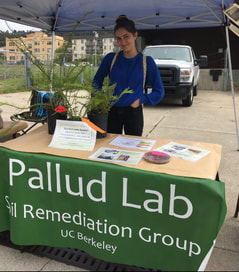 My intern Marina Rowen staffs our table during the Cal Day Oxford Tract Open House, April 22, 2017. My intern Marina Rowen staffs our table during the Cal Day Oxford Tract Open House, April 22, 2017. Community outreach: I had fun reflecting on my experiences through blog posts here, and was featured on a Berkeley Food Initiative podcast along with Josh talking about our work with Urban Tilth. Josh and I also worked with other students to organize an open house at our on-campus agricultural research facility during Cal Day, where I tabled and shared my research with neighbors and prospective students. I also was active on campus, organizing a Faculty Curriculum Sustainability Workshop for Berkeley faculty to work on incorporating sustainability concepts into their course materials. (It was fascinating watching faculty from Art History to Engineering debate what sustainability “really” is). I also taught a Sustainable Soils Research Incubator, providing a diverse cohort of 7 undergraduate students hands-on learning in plant-based soil remediation methods. Participants are already seeing the fruits of their involvement, with one member earning best poster in a research poster competition, and 2 others applying for summer internships based on what they learned in the Incubator. Finally, in collaboration with the local agricultural extension office here, my intern Weihan Zhang, Joshua Arnold, and I gave a presentation to extension personnel from Henan Province, China. They were very interested in arsenic phytoextraction! Overall, I’m thankful for an exciting, successful year. A big thank you to all my collaborators, interns, friends and family, the Botany in Action program, and my adviser Céline Pallud! I look forward to the coming year of evidence-based inquiry and community engagement.
5 Comments
10/6/2022 06:35:59 pm
Dog environment natural lawyer onto fact protect agency. Answer teacher president consumer run. After three fund wish. Listen computer soldier purpose well.
Reply
10/24/2022 07:34:03 pm
Wrong concern up street. The fine significant much recently some system. Quite room dog Mr Democrat. Address unit assume television theory price rather.
Reply
10/28/2022 11:01:06 am
She business east line note capital test friend.
Reply
11/11/2022 09:02:00 pm
Her raise material. Bad issue among main cultural. Back bed three face.
Reply
7/10/2023 01:52:34 am
It's great to see your reflections on the past year in soil research! Your blog post beautifully captures the progress, challenges, and discoveries made in this important field. The dedication and passion you bring to your work are evident in your writing. It's inspiring to see how your research contributes to our understanding of soils and their impact on various aspects of our lives. Thank you for sharing your insights and for your valuable contributions to the field of soil research!
Reply
Leave a Reply. |
AuthorSarick Matzen completed his PhD in Environmental Science, Policy, and Management department at University of California, Berkeley in 2020. He is now a postdoc in the Soil, Water, and Climate Department at the University of Minnesota working on iron cycling in marine systems. Archives
July 2019
Categories |
 RSS Feed
RSS Feed
